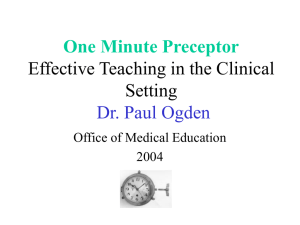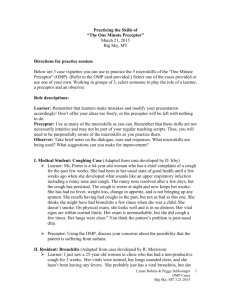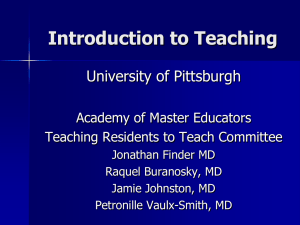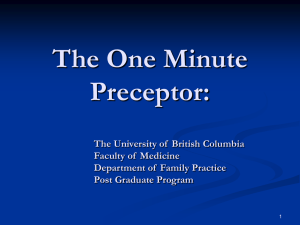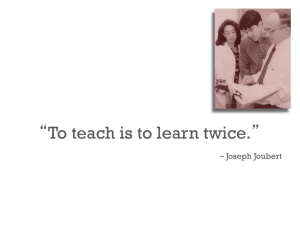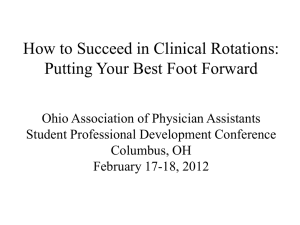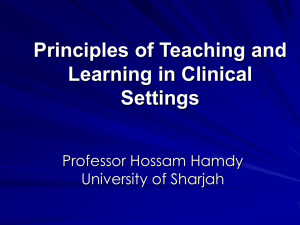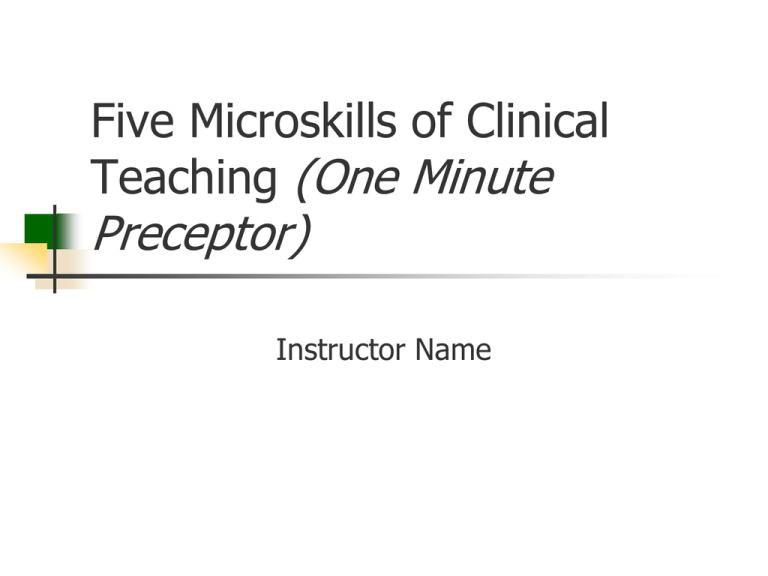
Five Microskills of Clinical
Teaching (One Minute
Preceptor)
Instructor Name
Goal
Residents will be able to effectively
integrate the 5 microskills of clinical
teaching into the daily clinical
routine.
Objectives
At the end of the session, the learner will
be able to:
Identify the 5 clinical microskills
Describe rationale for each of the
microskills
Demonstrate the technique for each of
the microskills
What You are Working With . . .
Your considerable medical knowledge
Your desire to be an effective teacher
Your uncertainty about what you may
need to teach
Your uncertainty how to best teach a
topic
Your limited time = Challenge to fit
teaching into your daily routine
What You Already Do …
Much of clinical teaching is discussing a
patient
Student/Intern interviews & examines
patient
Presents to preceptor (i.e., YOU)
Make clinical decisions
Diagnosis, tests to order, treatment
On average, this takes approximately
10-minutes
What You Already Do …
Teacher Reasoning During Case
Presentations & 5 Microskills for Clinical
Teaching
Example
Student: "I just examined a 26 year-old female,
with dysuria for the past few days. She has
never had a urinary tract infection. She denies
abdominal pain, fever or seeing blood in her
urine. She thinks her last menstrual period was
a couple of weeks ago. I don’t know if she is
sexually active. I wasn’t sure if I was supposed
to ask those kinds of questions.”
Example
Student: "On exam, she looked well. She was
afebrile and the rest of her vital signs were O.K.
Her lungs were clear and her heart was regular
without any murmurs. Her abdomen was soft
and not tender and I didn’t think her spleen or
liver were enlarged. That’s all I examined."
Example
Preceptor : "Get a urine and write for Cipro.”
In this example, the student was not given
an opportunity to learn or really think rather,
the student was simply told what to do.
Five Microskills of Teaching
1.
2.
3.
4.
5.
Obtain a commitment
Probe for supporting evidence
Teach general rules
Reinforce what was right
Correct mistakes
Neher JO, Gordon KC, Meyer B, Stevens N. A five- step "microskills" model of
clinical teaching. Journal of the American Board of Family Practice 1992; 5:419 424.
No. 1: Obtain a Commitment
When the case is presented to you ask the
learner what they think
Example Questions LIKELY to Get a
Commitment:
“What do you . . .
think is going on with this patient?”
want to do next in the work-up?”
want to accomplish during this
hospitalization?”
No. 1: Obtain a Commitment
Commitment on ANY clinical decision . . .
What other diagnoses would you consider?
What lab tests do you think we should get?
How should we treat this patient?
What antibiotic do you want to use?
Do you think the patient needs to be
hospitalized?
Based on the history, what parts of the
physical exam should we focus on?
No. 1: Obtain a Commitment
Example questions NOT LIKELY to get a
commitment:
“Sounds like pneumonia, don’t you
think?”
“Anything else?”
“Did you find out which symptoms
came first?”
No. 2: Probe for Supporting
Evidence
When discussing the case, before offering your
opinion, ask learners for evidence supporting
their opinion
Helpful approaches:
“What were the major findings that led to
your conclusions?”
“What else did you consider?”
“What did you rule out that choice?”
No. 2: Probe for Supporting
Evidence
Non-helpful approaches:
“What are the possible causes of the
elevated temperatures?”
“I don’t think this is good. Do you have
any other ideas?”
“This seems to be a classic case of . . .”
“What do you know about her last
admit?”
No. 3: Teach General Rules
Learner’s responses reveal that he/she need to
know something.
Provide general rules, concept, etc at learner’s
level of understanding.
Helpful approaches:
“If patient only has . . . then . . . is not possible.”
Patients with . . . usually experience pain w/ . . .
The labs should show . . .”
No. 3: Teach General Rules
Non-helpful approaches:
“This patient needs . . . now. Don’t
start the . . . until tomorrow.
“I’m convinced that to diagnose . . . you
need a . . . “
No. 4: Reinforce What They
Did Right
Learner has handled the situation well
Comment on the SPECIFIC good work
and effect it had
Helpful approach:
“You did a very thorough job evaluating
the patient’s abdominal complaints.
Identifying the . . . was critical in
making the diagnosis.”
No. 4: Reinforce What They
Did Right
Non-helpful approaches:
“You are absolutely right. That was a
wise decision.”
“Nice job taking care of those patients
today.”
No. 5: Correct Mistakes
Learner has demonstrated mistakes
Find appropriate time and place to
discuss ASAP.
First allow learner to own performance.
You then detail negative effect &
correction needed.
No. 5: Correct Mistakes
Helpful approach:
“I agree the patient is probably drug seeking,
but we still need to do a careful H&P before
we make any recommendation.”
Non-helpful approaches:
“You did what?”
“I can’t believe you ever got into medical
school!”
Microskill Demonstration
Teaching Scenarios
Videos from the University of California, Irvine’s BEST Program: Copyright ©
2003-2006 The Regents of the University of California. All rights reserved.
Microskills of Teaching
1.
2.
3.
4.
5.
Obtain a commitment
Probe for supporting evidence
Teach general rules
Reinforce what was right
Correct mistakes
Neher JO, Gordon KC, Meyer B, Stevens N. A five- step "microskills" model of
clinical teaching. Journal of the American Board of Family Practice 1992; 5:419 424.
Example
Student: "I just examined a 26 year-old female,
with dysuria for the past few days. She has
never had a urinary tract infection. She denies
abdominal pain, fever or seeing blood in her
urine. She thinks her last menstrual period was
a couple of weeks ago. I don’t know if she is
sexually active. I wasn’t sure if I was supposed
to ask those kinds of questions.”
Example
Student: "On exam, she looked well. She was
afebrile and the rest of her vital signs were O.K.
Her lungs were clear and her heart was regular
without any murmurs. Her abdomen was soft
and not tender and I didn’t think her spleen or
liver were enlarged. That’s all I examined.“
Based on what you just learned about
microskills, what would be a better
question to ask?
1. Get a Commitment
Preceptor: "What do you think is her
problem?"
Student: "I am concerned that it might
be a urinary tract infection."
2. Probe for Understanding
Preceptor: "What do you see here that
Student: "She has pain on urination but
Preceptor: “What else could she have?”
might indicate a urinary tract infection?”
not much of a problem with frequency
or urgency of urination. I thought UTIs
had other symptoms like that.”
3-5. Teach General Rules, Provide
Positive Feedback, Correct Errors
Preceptor: "You identified the most
probable concern in this case but you
need to complete the physical exam
and get a sexual history. Without
more information, we can’t be sure of
what we have."
3-5. Teach General Rules, Provide
Positive Feedback, Correct Errors
Preceptor: "Do you want me to model
how to take a sexual history and do a
pelvic examination or would you like
me to observe you do them?“
Student: "I would really appreciate
your demonstrating how to do them.“
Preceptor: “Okay, let’s go and see the
patient."
Key Points
Your teaching time is limited
Make the most of the time you have
Incorporate it into what you do
everyday
Microskills enable you to effectively
assess, instruct, and give feedback
more efficiently
Questions???

